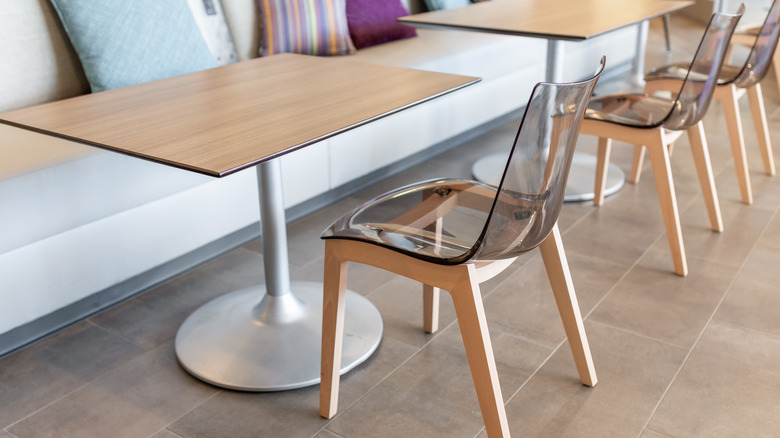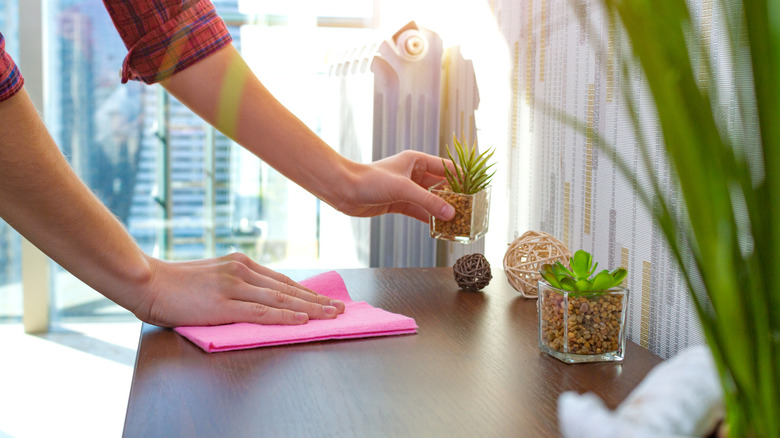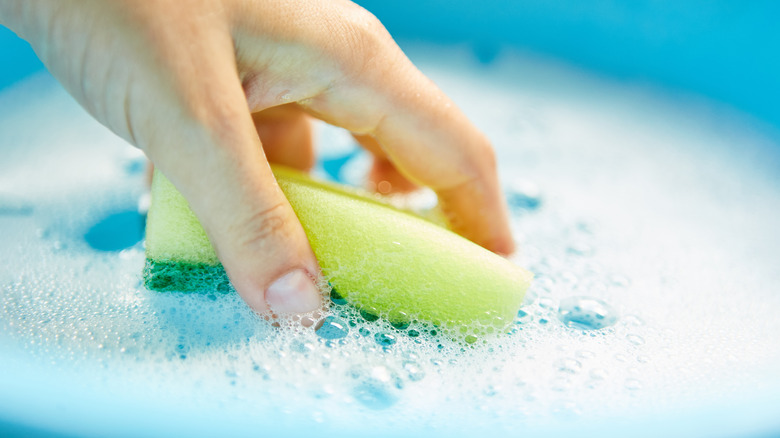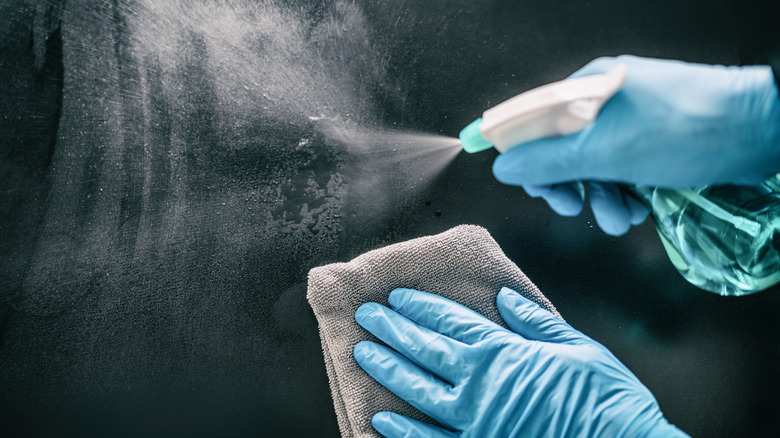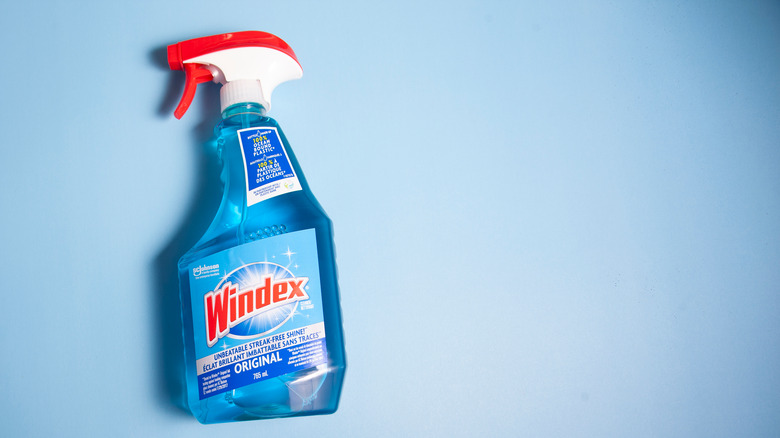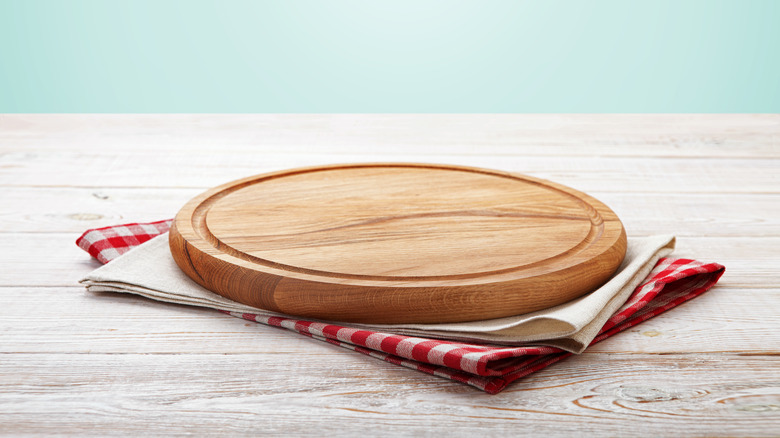Best Ways To Clean Acrylic Furniture
If you are looking for a way to make your home more fun and attractive, acrylic furniture is one way to go. Far removed from traditional wooden styles, acrylic furniture boasts a variety of unique colors or can even be completely clear. Along with the unique style that acrylic furniture can bring to your home, UV Plastic states that the material is strong and durable, perfect for a variety of settings and uses. The only downside to acrylic furniture is that it's rather expensive.
According to Clear Home Design, after its creation in the 1930s, acrylic furniture became increasingly popular in home designs of the 60s and 70s. Although the style didn't last, it is beginning to make comeback in many modern homes. So, if you're ready to make the investment, there are several tips and tricks to keep your acrylic furniture looking its best for longer, and thankfully, the process of cleaning and maintaining acrylic furniture is not difficult at all.
1. Regular maintenance
One of the best ways to keep your acrylic furniture looking beautiful for as long as possible is to maintain it on a regular basis. Clear Home Designs states that regular maintenance should be done at least once a week. Depending on the extent of the furniture's use, this usually doesn't require much more than wiping over the furniture with a damp microfiber cloth. Cleaning on a regular basis prevents the build-up of dirt and grime, which could potentially damage the surface with scratches or other unwanted marks.
Whether cleaned regularly or not, however, if scratches do occur, they should also be treated in a timely manner. According to Clear Home Designs, small scratched should be buffed out using acrylic polish as soon as you discover them to prevent further damage. If left untreated, the scratches can easily multiply or even cut deeper into the furniture, making them even more difficult, or eventually impossible to remove.
2. Dusting acrylic furniture
Although dusting furniture seems simple enough, dusting acrylic furniture takes some extra precautions. Made Goods claims that as insignificant as a speck of dust may seem to be, it can cause significant scratches on your acrylic furniture if not dealt with properly. For this reason, you should never use a dirty or lint-producing cloth to remove dust from your acrylic furniture. Instead, Made Goods highly recommends using a soft, non-abrasive, lint-free cloth for dusting.
When dusting, you should always check to ensure sharp particles are not stuck onto your cloth to avoid marking your furniture. To further avoid scratches, you should also avoid pressing too hard onto your furniture or dragging your cloth across the furniture to remove dust. One Good Thing claims that a hair dryer can also be used to gently remove dust from furniture, avoiding the risk of scratches altogether. Simply blow the dust off of the surface of your furniture and later vacuum it off the floor when it has settled.
3. Soap and water
If you notice that your acrylic furniture is becoming a little cloudy, it may be time to take your routine maintenance a step further. One of the easiest ways to give your acrylic furniture a deep clean is by using simple soap and water. City Chic Decor mentions that all you will need is a spray bottle, 1 cup of water, 1 teaspoon of dish soap, and several microfiber cloths.
Start by mixing together the water and soap and pouring it into the spray bottle. When the solution is ready, make sure the furniture is free of any obvious debris, spray it liberally over the surface, and gently rub the grime away with a microfiber cloth. When finished, use another clean microfiber cloth and dampen it with clean water before wiping down the surfaces again. Finally, finish off by drying the furniture with another clean and dry microfiber cloth.
4. Acrylic cleaner
While harsh chemicals can cause damage and break down acrylic material, plastic cleaning solutions and acrylic polishes are gentle and safe to use with acrylic furniture. AcmePlastics.com claims that the best acrylic cleaners are sold by Novus cleaning products. Not only are Novus products safe to use on any acrylic furniture you may own, but they also help prevent fogginess that may occur over time, resist the build-up of dust, and get rid of static that may build up from friction.
According to Clever start by cleaning and dusting away dirt and debris from your furniture's surface. This will prevent any unwanted damage, like scratches, from occurring during the cleaning process. Then, apply the plastic cleaner to the surface with a dry microfiber cloth and buff the area with a different clean microfiber cloth. Do this in small sections until the entire surface of furniture has been cleaned.
5. Removing scratches
Clever explains that Novus's polish kit is a great tool if you need to remove minor scratches from your acrylic furniture. More serious scratches, however, will need the attention of a professional who will restore the furniture by buffing the scratches away. When using the kit to remove minor scratches on your own, Device's Plastics Inc. states that you should always start with a clean surface. Once the surface is clean, you can then observe the condition of your furniture and the severity of the scratches.
Polishing kits remove scratches and damage rather than filling them in. This means that the deeper the scratch the more pressure will be needed to remove it. Start by applying your reviving solution to the affected surface and use a clean, soft cloth to polish with firm back-and-forth strokes. Continue this process until the scratches have disappeared. Let it dry for a few minutes before wiping any excess solution away with a clean cloth and buffing the area to a shine.
6. Steer clear of ammonia
Windex, as well as other glass cleaners, are known for removing smudges or grime on glass and mirrors. Since acrylic furniture is similar in appearance to glass, you may think that a glass cleaner will have a similar effect. Unfortunately, this is not the case. Glass cleaner contains a chemical called ammonia, which causes more harm than good when it comes to acrylic furniture.
Muniz clearly states that you should never use cleaners that contain ammonia to clean your acrylic furniture. Sklar further explains that ammonia can cause permanent cloudiness if used to clean the surface of your acrylic furniture. This cloudiness emerges because ammonia breaks down the components that make up the acrylic material, causing irreversible damage. Before using any type of cleaner on acrylic furniture, always test the product in an inconspicuous area to ensure it does not contain any traces of ammonia and avoid unwanted damage.
7. Preventing future damage
Just as important as cleaning and maintaining your acrylic furniture, it is also recommended to prevent damage wherever possible. Clever mentions that one of the best ways to care for your acrylic furniture is to cover it up when it is not in use, which can be done with any type of soft sheet or cloth. This not only prevents dust from accumulating, but it also keeps it safe from other elements that could potentially scratch or damage the material.
While in use, you can also protect your acrylic furniture by using felt pads on the table's surface and taking precautions when moving items across or off the piece of furniture by carefully picking it up rather than dragging it. Another way to prolong the life of acrylic is to keep it away from UV rays and extreme temperature changes, which can degrade the material, especially with cheaper acrylic furniture, notes Plastikcity.
